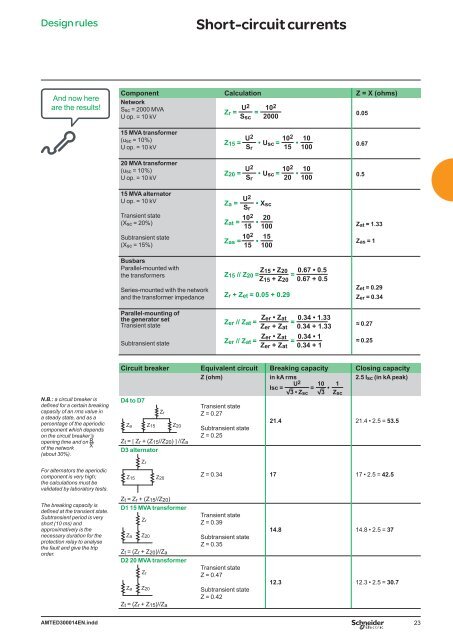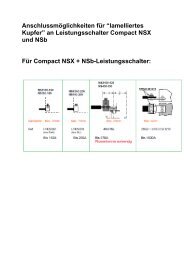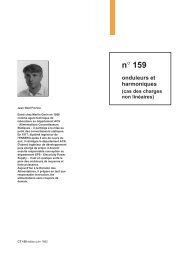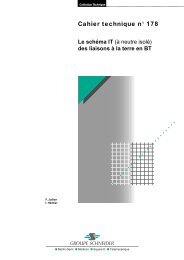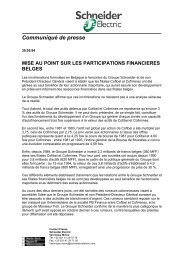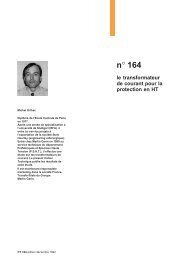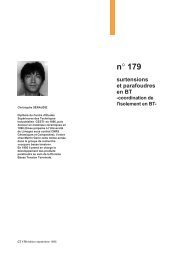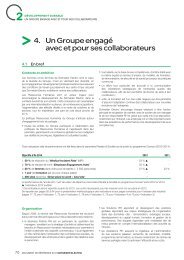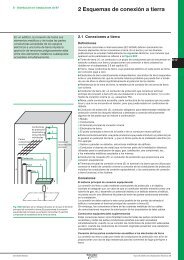Medium Voltage technical guide - Schneider Electric
Medium Voltage technical guide - Schneider Electric
Medium Voltage technical guide - Schneider Electric
Create successful ePaper yourself
Turn your PDF publications into a flip-book with our unique Google optimized e-Paper software.
Design rules Short-circuit currents<br />
And now here<br />
are the results!<br />
N.B.: a circuit breaker is<br />
defined for a certain breaking<br />
capacity of an r ms value in<br />
a steady state, and as a<br />
percentage of the aperiodic<br />
component which depends<br />
on the circuit breaker’s<br />
opening time and on R X<br />
of the network<br />
(about 30%).<br />
For alternators the aperiodic<br />
component is very high;<br />
the calculations must be<br />
validated by laboratory tests.<br />
The breaking capacity is<br />
defined at the transient state.<br />
Subtransient period is very<br />
short (10 ms) and<br />
approximatively is the<br />
necessary duration for the<br />
protection relay to analyse<br />
the fault and give the trip<br />
order.<br />
AMTED300014EN.indd<br />
Component Calculation Z = X (ohms)<br />
Network<br />
Ssc = 2000 MVA<br />
U op. = 10 kV<br />
15 MVA transformer<br />
(usc = 10%)<br />
U op. = 10 kV<br />
20 MVA transformer<br />
(usc = 10%)<br />
U op. = 10 kV<br />
15 MVA alternator<br />
U op. = 10 kV<br />
Transient state<br />
(Xsc = 20%)<br />
Subtransient state<br />
(Xsc = 15%)<br />
Busbars<br />
Parallel-mounted with<br />
the transformers<br />
Series-mounted with the network<br />
and the transformer impedance<br />
Parallel-mounting of<br />
the generator set<br />
Transient state<br />
Subtransient state<br />
Zr = U2<br />
Ssc<br />
Z15 = U2<br />
Sr<br />
Z20 = U2<br />
Sr<br />
Za = U2<br />
Sr<br />
Zat = 102<br />
15<br />
Zas = 102<br />
15<br />
102 = 0.05<br />
2000<br />
=<br />
• Usc<br />
=<br />
• Usc<br />
• Xsc<br />
• 20<br />
100<br />
• 15<br />
100<br />
10 2<br />
15<br />
10 2<br />
20<br />
• 10<br />
100<br />
• 10<br />
100<br />
Z15 • Z20 0.67 • 0.5<br />
Z15 // Z20 = =<br />
Z15 + Z20 0.67 + 0.5<br />
Zr + Zet = 0.05 + 0.29<br />
Zer • Zat<br />
Zer // Zat =<br />
Zer + Zat<br />
Zer • Zat<br />
Zer // Zat =<br />
Zer + Zat<br />
0.34 • 1.33<br />
=<br />
0.34 + 1.33<br />
0.34 • 1<br />
=<br />
0.34 + 1<br />
0.67<br />
0.5<br />
Zat = 1.33<br />
Zas = 1<br />
Zet = 0.29<br />
Zer = 0.34<br />
≈ 0.27<br />
≈ 0.25<br />
Circuit breaker Equivalent circuit Breaking capacity Closing capacity<br />
Z (ohm) in kA r ms<br />
U 10 1<br />
2<br />
Isc = =<br />
3 • Zsc<br />
•<br />
3 Zsc<br />
2.5 Isc (in kA peak)<br />
D4 to D7<br />
Zr<br />
Transient state<br />
Z = 0.27<br />
Za Z15 Z20<br />
Subtransient state<br />
21.4 21.4 • 2.5 = 53.5<br />
Z = 0.25<br />
Zt = [ Zr + (Z15//Z20) ] //Za<br />
D3 alternator<br />
Z15<br />
Zr<br />
Z20<br />
Zt = Zr + (Z15//Z20)<br />
D1 15 MVA transformer<br />
Za<br />
Zr<br />
Z20<br />
Zt = (Zr + Z20)//Za<br />
D2 20 MVA transformer<br />
Za<br />
Zr<br />
Z20<br />
Zt = (Zr + Z15)//Za<br />
Z = 0.34 17 17 • 2.5 = 42.5<br />
Transient state<br />
Z = 0.39<br />
Subtransient state<br />
Z = 0.35<br />
Transient state<br />
Z = 0.47<br />
Subtransient state<br />
Z = 0.42<br />
14.8 14.8 • 2.5 = 37<br />
12.3 12.3 • 2.5 = 30.7<br />
23


